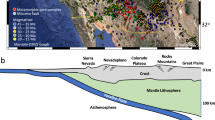Abstract
Surface topography (whether subaerial or submarine) is a product of plate tectonic, geological, climate and surface processes. Plate tectonic processes, predominantly operated through earthquake cycle, dominate, at least in the seismically active regions, and are responsible for a significant amount of topography build up. On a shorter time scale, they appear to cause devastation, but on a longer time scale, they lead to the development of diverse landscapes which not only makes them look beautiful but also inhabitable. The topography build-up, due to deformation caused by earthquake processes, depends upon the mechanism of deformation and earthquake occurrence. The earthquake occurrence mechanism is different in the plate boundary regions as compared to that in the plate interior regions. Here in this article, I discuss the nuances of crustal deformation in the interplate and intraplate regions in the context of India and India plate.
Similar content being viewed by others
Suggested Reading
P Molnar and Philip England, Late Cenozoic uplift of mountain ranges and global climate change: chicken or egg? Nature, Vol.346, pp.29–34, 1990.
H F Reid, The Mechanics of the Earthquake, The California Earthquake of April 18, 1906, Report of the State Investigation Commission, 2, Carnegie Institution of Washington, Washington, D.C. 1910.
S Mazzotti, Geodynamic models for earthquake studies in intraplate North America, Geological Society of America Special Papers, Vol.425, pp.17–33, 2007 doi:https://doi.org/10.1130/2007.2425(02).
V K Gahalaut, et al., Geodetic constraints on tectonic and anthropogenic deformation and seismogenesis of Koyna-Warna region, India, Bulletin Seismological Society of America, 108(5B), pp.2933–2942, 2018, doi: https://doi.org/10.1785/0120170373.
V K Gahalaut, et al., Geodetic evidence of high compression across seismically active Kachchh paleo-rift, India, Tectonics, Vol. 38, No. 8 pp. 3097–3107, 2019, doi: https://doi.org/10.1029/2019TC005496.
R K et al., Strong seismic coupling underneath Garhwal-Kumaun region, NW Himalaya, India, Earth and Planetary Science Letters, Vol.506, pp.8–14, 2019.
Acknowledgment
I am thankful to Dr Nandini Nagrajan for encouraging me to write this paper. I thank the anonymous reviewer who saved me from my overenthusiasm and my strong bias towards earthquake processes leading to topography build up. This is CSIR-NGRI contribution number NGRI/Lib/2020/Pub-43.
Author information
Authors and Affiliations
Corresponding author
Additional information
Vineet Kumar Gahalaut is Chief Scientist at CSIR-National Geophysical Research Institute, Hyderabad. He is involved in research related to earthquake processes, tectonic geodesy, seismology and geodynamics. He is a Fellow of the Indian Academy of Sciences (FASc), Bangalore.
Rights and permissions
About this article
Cite this article
Gahalaut, V.K. Continent Deformation Due to Earthquake Cycle and Landscape Evolution. Reson 26, 245–256 (2021). https://doi.org/10.1007/s12045-021-1123-2
Published:
Issue Date:
DOI: https://doi.org/10.1007/s12045-021-1123-2




